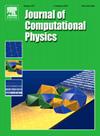An augmented fourth order domain-decomposed method with fast algebraic solvers for three-dimensional Helmholtz interface problems
IF 3.8
2区 物理与天体物理
Q2 COMPUTER SCIENCE, INTERDISCIPLINARY APPLICATIONS
引用次数: 0
Abstract
A new Augmented Matched Interface and Boundary (AMIB) method with the fast Fourier transform (FFT) acceleration is proposed for three-dimensional (3D) Helmholtz interface problems. This method inherits the merits of the existing FFT-AMIB method for Poisson interface problems, such as the FFT efficiency and effective treatments of different boundary conditions including Dirichlet, Neumann, Robin and their arbitrary combinations. However, the previous FFT-AMIB method is not applicable to Helmholtz interface problems due to the discontinuous wavenumbers in the Helmholtz equation. To overcome this difficulty, the Helmholtz interface problem is decomposed into two subproblems, each defined on a subdomain with the zero-padding on the other. Consequently, the original problem can be transformed into two elliptic interface problems, which allow the FFT inversion. Besides the domain decomposition, the new AMIB method possesses several novel features. In resolving interfaces with complex shapes, the jump conditions are enforced along Cartesian directions, instead of along normal directions as in the existing ray-casting AMIB scheme. Various fourth order corner treatments have been developed in the Cartesian Matched Interface and Boundary (MIB) scheme to ensure robustness. Moreover, an optimized iterative algorithm combining the GMRES and BiCGSTAB has been designed in solving the auxiliary variables involved in the Schur complement solution of the augmented system. Extensive numerical experiments show that the method achieves fourth order accuracy for both solutions and gradients, with an overall complexity of for a uniform grid.
求助全文
约1分钟内获得全文
求助全文
来源期刊

Journal of Computational Physics
物理-计算机:跨学科应用
CiteScore
7.60
自引率
14.60%
发文量
763
审稿时长
5.8 months
期刊介绍:
Journal of Computational Physics thoroughly treats the computational aspects of physical problems, presenting techniques for the numerical solution of mathematical equations arising in all areas of physics. The journal seeks to emphasize methods that cross disciplinary boundaries.
The Journal of Computational Physics also publishes short notes of 4 pages or less (including figures, tables, and references but excluding title pages). Letters to the Editor commenting on articles already published in this Journal will also be considered. Neither notes nor letters should have an abstract.
 求助内容:
求助内容: 应助结果提醒方式:
应助结果提醒方式:


